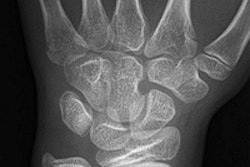The Image Gently radiation dose reduction campaign has launched a new initiative targeting the most common imaging exam of all: radiography. The group's new Back to Basics initiative, launched today, is intended to strengthen radiation protection in children as radiography shifts from analog film to digital x-ray.
The Alliance for Radiation Safety in Pediatric Imaging, which represents 71 medical organizations and more than 500,000 healthcare providers worldwide, has developed online teaching materials, checklists, and practice quality improvement projects for the new campaign. All of these materials are available free of charge and are posted on the Image Gently website.
The campaign emphasizes the need for a standardized approach by measuring patient body size and developing technique charts. It is targeted to radiologists, radiologic technologists, medical physicists, and radiology department staff. At least 10 million x-ray exams were performed on children in 2010, according to the alliance.
Back to the future?
"Digital radiology has brought many improvements to imaging; however, some of the technical factors and processes used for digital imaging differ from those used in screen-film radiology," said the campaign's co-chair, Dr. Susan John, professor of radiology and chairman of the diagnostic and interventional imaging department of the University of Texas Medical School.
"This initiative seeks to make radiology medical professionals aware of the differences and how to account for them," she said. "Modern radiation reduction techniques include a return to simple techniques, such as collimation."
Campaign co-chair Dr. Steven Don, an associate professor of radiology at the Mallinckrodt Institute of Radiology, agreed. "Since the introduction of the first computed radiography equipment, exposure creep has been a problem with digital radiography. Over time, exposure factors rise, and radiologists may not be aware of this," he said.
Getting back to basics
Don said that the idea of a "back to basics" campaign germinated at an alliance-sponsored digital radiography (DR) summit held in February 2010 at Mallinckrodt. In addition to alliance members, attendees included representatives of the U.S. Food and Drug Administration (FDA), 12 professional associations, and 10 equipment manufacturers organized through the Medical Imaging and Technology Alliance (MITA).
"The launch of the Back to Basics campaign started at this meeting," Don said. "Our objective was to reinforce techniques used with screen-film radiography that are equally applicable when using digital equipment to perform an x-ray exam."
In addition, summit attendees agreed that standardization of terminology used with various computed radiography (CR) and DR equipment was of critical importance. This would eliminate the confusion of terminology from different vendors, especially for technologists who use several different vendors' equipment in their radiology departments. Everyone at the summit agreed to accept the terminology of the International Electrotechnical Commission (IEC) standard.
"Eventually there will be only one set of exposure terminology being used for the exposure index, the exposure index target, and the deviation index," Don explained. CR and DR vendors will incorporate the standard in their equipment; some have already done so.
What the campaign emphasizes for low-dose exams
The most important habit being reintroduced is to measure the thickness of a pediatric patient to select the most appropriate imaging technique. Technologists will be encouraged not to rely on digital image processing to correct for over- or underexposure.
Technologists will also be encouraged to avoid using grids whenever possible. Grids remove scatter, but scatter starts to affect an image only when there is 12 cm of water thickness or greater. Very young children may not need a grid, and a grid may also be unnecessary when imaging a body part less than 10- to 12-cm thick, such as a wrist or a foot.
Another focus is that only the indicated area should be exposed to radiation. This can be achieved with proper collimation and shielding. A survey of 450 technologists by the American Society of Radiologic Technologists (ASRT) revealed that half of the respondents used electronic cropping after the exposure (Pediatric Radiology, May 2011, Vol. 41:5, pp. 602-610).
Don emphasized that this habit, of which radiologists might not be aware, needs to change. John also noted that proper collimation delivers low-dose exams to the targeted body part.
The Back to Basics campaign also reinforces the need to check exposure indicators, maintain image quality, and take such initiatives as creating a technique chart.
Material for the campaign was prepared by pediatric radiologists, radiologic technologists, and medical physicists. Medical physicist Robert MacDougall, PhD, of Lurie Children's Hospital of Chicago, was particularly involved, writing content material and reviewing all of the material prepared for the campaign for accuracy.
In addition to the new DR campaign, Image Gently has launched campaigns for CT, nuclear medicine, interventional radiography, and fluoroscopy.


















